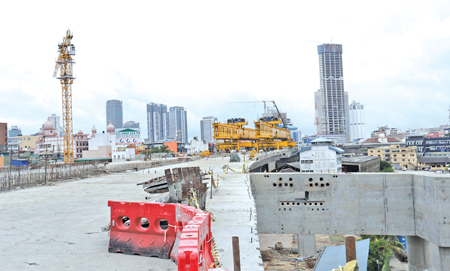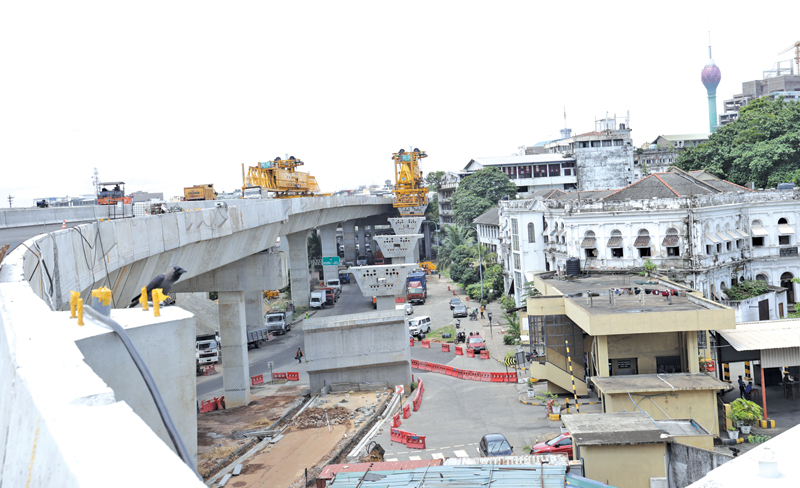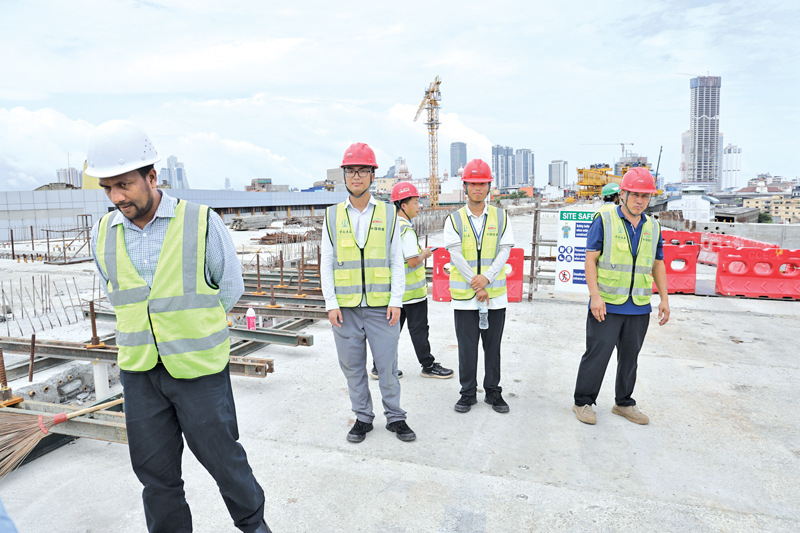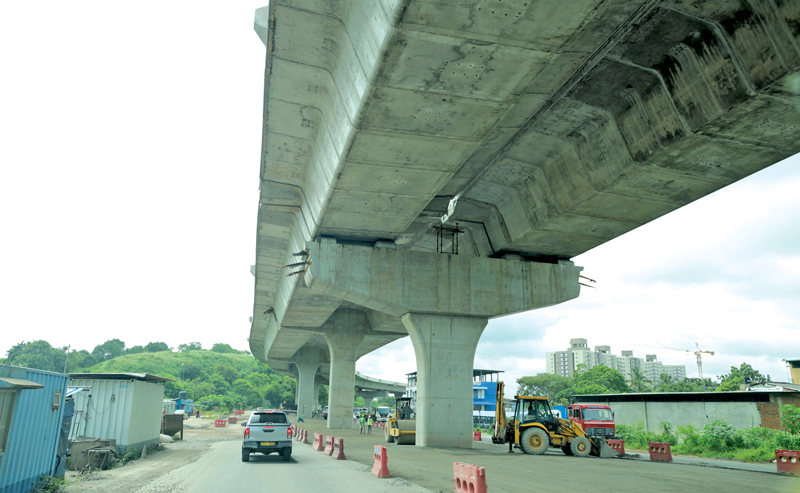An asphalt artery, and in time, a big boost to the city’s commerce and growth; The Port Access Elevated Highway (PAEH) is not just a great big road in the sky, it’s a testament to Sri Lanka’s relentless spirit in the face of adversity and symbol of friendship with international partners.
You can’t miss it if you have been around Fort or Pettah, two yellow behemoths laying concrete extensions over four-storeys high, blocking out the afternoon sun and causing quite the din on top of the freighters in the Colombo harbour. The elevated road linking the Colombo Port, Port City and Galle Face to Peliyagoda is almost complete and will be opened to the public by October this year.
The project was executed under an Asian Development Bank loan of USD 300 million. The contractor for the project is China Civil Engineering Construction Corporation (CCECC). The PAEH is the latest of flyover projects built in the Colombo District this year, with two completed in Kompanna Vidiya and the latest opened last Tuesday (16) spanning the busy Kohuwela intersection.
Major project
The PAEH project commenced in 2019 and is scheduled to be completed this year. During the media tour of the project site on Thursday (18), Project Director Wimal Kandambi said that the PAEH is the only major project that the Covid-19 pandemic and economic crisis didn’t halt.

China Civil Engineering Construction Corporation (CCECC) Sri Lanka GM Xu Yunxiang (left) and Project Director Wimal Kandambi (centre)
“We continued this project despite the Covid-19 pandemic. During the pandemic, we had to quarantine entire work crews when one got infected,” he said while speaking about challenges. Other challenges included a diesel shortage during the economic crisis, security issues, the constant container movement and land acquisition.
Kandambi also said that the project was quite a challenge, because unlike other highways, the PAEH was built in a metropolitan area. “We had to be careful not to sever any utilities when building the foundation. While excavating, we encountered water, electricity, telecommunication, sewer lines and even utilities from the 1800s”.
As far as the traffic situation goes, the PAEH will provide a viable solution to the severe traffic congestion in Colombo, especially for vehicles entering the city’s busy Northern nexus with the A1 highway (Colombo-Kandy road), and A3 highway (Colombo-Puttalam via Negombo road) and E03 Expressway (Colombo-Katunayake Expressway). The PAEH connects the E03 via the New Kelani Bridge and Orugodawatte off-ramp; providing easy access to the city.
With off-on points at Galle Face, Pettah, Aluthmawatha Road and Ingurukade, the PAEH will boost connectivity in key points in Northern Colombo and ease traffic on the main roads, besides providing a new access road for container transport from the port. The PAEH is also slated to create new jobs and promote investment opportunities. One of the commendable goals of the project is to minimise environmental pollution and increase fuel efficiency.
New chapter
Inspecting the construction site on Thursday, Transport, Highways and Mass Media Minister Dr. Bandula Gunawardena told the media that the PAEH will turn a new chapter in Sri Lanka’s highway history. “A tunnel will be built to connect the highway to the Marine Drive via the Port City to preserve the beauty of Galle Face. With the PAEH, it will just take a four-minute drive to get from Galle Face to Peliyagoda.
“Local engineers and workers make up 70 percent of the workforce in this project and they learned a huge deal. This project will greatly help in the development of Colombo Harbour. As freight traffic will have a new entry point, traffic mainly around Orugodawatta, Baseline Road and the surrounding areas will reduce significantly. We are also planning to hold a workshop on July 24 at Cinnamon Lakeside to educate engineering undergrads, engineering stream A/L students and the public on the latest technology used in this project,” the Minister said.
“A new flyover constructed in Kohuwela with financial support from the Hungarian Government, was commissioned on Tuesday (16). We also expect to commence work shortly on a new flyover in Gatembe in Kandy, with financial assistance from the Hungarian Government.
A loan of Rs 800 billion has been obtained to construct highways. But the annual revenue from the highways is only Rs.5 billion. Hence, it will take nearly 160 years to repay the debt from this annual revenue”.
Routine checks

Colombo skyline
Project Director Kandambi said the PAEH was constructed with Pre-cast Box Girder segments; a new technique used for the first time to build Sri Lanka’s highways. “Around 3,279 segments have been installed for the PAEH which spans 5.3 km”. The Box Girders are fairly large, allowing maintenance crews to carry out routine checks.
The four-track highway has been widened to six lanes in certain parts. Pointing at the launching machines, Kandambi said that the huge cranes are the ‘main characters’ of this story. “The launching machines made the whole operation possible. They are used in segmenting, levelling and holding post tension”.
Transport, Highways and Mass Media Ministry Secretary Ranjith Rubasinghe said steps should be taken to increase interest among Sri Lankan engineers on the latest technology used in this project and to obtain their services for future development projects instead of relying on foreigner experts. Also the PAEH will be the first to feature a Multi-Lane Free Flow Electronic Toll Collection system (MLFF-ETC), for the convenience of motorists.
As the PAEH approaches its grand opening in October, it stands as a remarkable achievement in Sri Lanka’s infrastructure development. Overcoming numerous challenges, from the pandemic to economic turmoil, the PAEH embodies the resilience and determination of the nation. Not only will it alleviate the chronic traffic congestion in Colombo, but it will also stimulate economic growth, create jobs, and introduce advanced construction techniques to local engineers. With its strategic connections and state-of-the-art features, the PAEH is poised to transform Colombo’s transportation landscape and pave the way for future advancements in the country’s highway network.

A section of PAEH

Chinese and Sri Lankan construction workers

Under the PAEH near what used to be the Bloemendhal landfill




